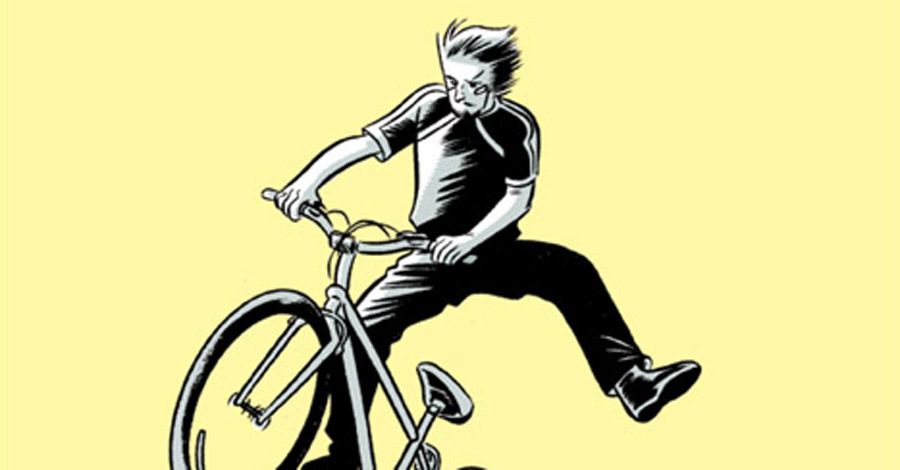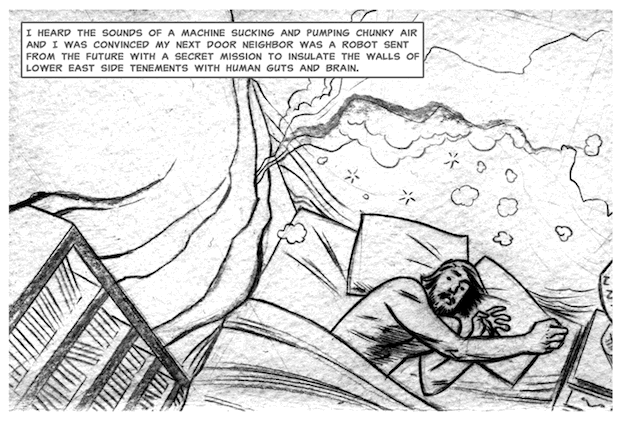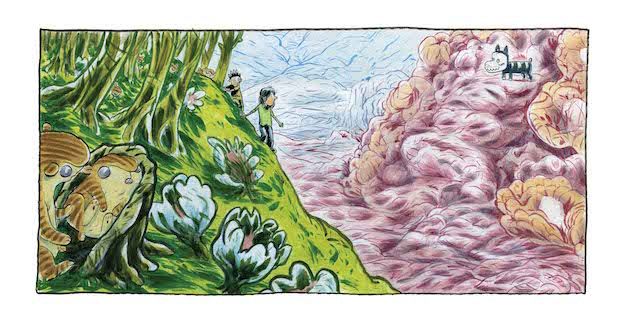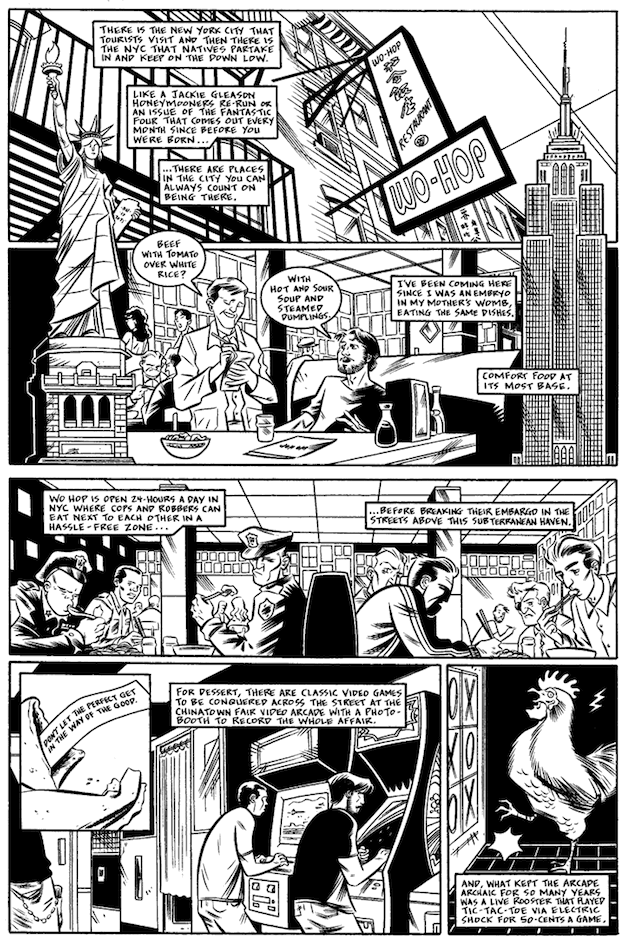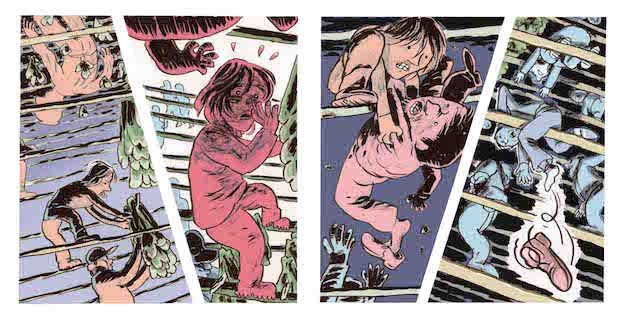Hang Dai Editions is the imprint of Hang Dai Studio, the Brooklyn collective formed by Dean Haspiel, Gregory Benton, Josh Neufeld and the late Seth Kushner. All of them were already well known, Haspiel as a prolific independent cartoonist as well as the artist for Archie Comics' The Fox, Benton as the creator of B+F, which won the MoCCA Festival award last year, Neufeld as the creator of A.D.: New Orleans After the Deluge and the artist for The Influencing Machine: Brooke Gladstone on the Media, and Kushner, who died in May, as a talented photographer and writer whose works included Leaping Tall Buildings, for which he photographed many prominent comics creators, and Schmuck.
The first titles to be published by Hang Dai were minicomics that the creators hand-sold at shows, but recently the collective announced a slate of comics that will be distributed to a wider audience this fall through Alternative Comics.
In an interview with ROBOT 6, Haspiel and Benton talk about the evolution of Hang Dai, the new fall line and the loss of Kushner. They also shared some art from their upcoming books Beef With Tomato (Haspiel) and Smoke (Benton).
ROBOT 6: I want to start out with what must be the elephant in the room for you: the loss of Seth Kushner. Can you tell me what part he played in creating Hang Dai and what place his work will have in your lineup going forward?
Dean Haspiel: Seth Kushner was a photographer/comix creator and founding member of Hang Dai Studios and Hang Dai Editions. When I left Deep6 Studios in 2011, I recruited five other artists to spark a new studio, and Seth was the first person I asked. We had become fast friends after I first met him for a photo shoot for his book, The Brooklynites, and discovered that we had comix in common. Little by small, we worked on several comix projects, including the Act-i-vate movie and other stuff. Seth had never been part of a studio before, so there was hesitation, but he grew to love the shared work environment. So much so we co-created TripCity.net, an online salon version of our studio with Chris Miskiewicz and Jeffrey Burandt. Between the time we spent physically and virtually, it felt like Seth was a Bat-phone call away at all times. Even though it's been almost two months since he passed away, I still think about Seth 20 times a day and stumble, knowing that I can't show him anything I'm working on and/or can't talk to him about anything and everything. When Seth died, a part of me died.
Gregory Benton: Seth was a huge part of my getting out of bed every morning. I looked forward to going to the studio, knowing he’d be there with his huge smile and positivity. He is the only person with whom I never spent a bad moment. I consider myself extremely fortunate to have been able to know him as a friend and studio mate. Even when he was sick he was full of optimism, energy, and humor. The hole Seth leaves at Hang Dai is vast. We lost our heart, frankly. Our thoughts are always with his wife, son and mother.
How much of Seth’s work do you have left to publish?
Haspiel: Seth's graphic novel Schmuck will debut in September, thanks to the efforts of his wife Terra, book designer Eric Skillman, Hang Dai, Alternative Comics and his Kickstarter supporters. I also have fully written scripts of his for The Brooklynite (co-created by artist Shamus Beyale), that may have found a home. And, there are other fully realized materials like a script for a proposed photocomic/screenplay that I helped edit with his co-writer Chris Miskiewicz, and the story outline for the rest of The Roman Nose that his co-creator/artist George Folz plans to complete. There's other posthumous stuff, too.
Benton: Seth was also working on a journal/memoir of his experience with his illness. He wrote a full script for the first 40 pages, with an outline and notes for the rest. Seth had been collaborating with Jonathan Allen, and the finished art so far looks incredible. We’ll see if there is a way to carry that forward.
Let’s drop back a bit: Can you talk about how Hang Dai came to be and how it’s different from your other collaborative efforts, like Act-I-Vate?
Haspiel: Act-I-Vate is a webcomix collective that I formed in 2006 and quit in 2011. I realized I needed to formulate a multimedia website to publish essays, podcast interviews, and curate and edit other forms of storytelling. Hang Dai started as a physical studio space in Brooklyn in 2011, where we launched TripCity.net, our experimental salon. It was our home base for individual and group projects. Then, one day, after griping about our print publishing woes, me, Seth and another studio mate, Gregory Benton, started talking about putting our money where our mouths were and created a publishing imprint. Something that we could fully control, hassles and all. Rather than come up with yet another name, we elected to stick with our studio brand and sparked Hang Dai Editions. A year later, we recruited my old high school pal and cartoonist Josh Neufeld to join us.
Benton: The first Hang Dai Editions publications debuted at Comic Arts Brooklyn in November of 2013. This was just a couple of months after we announced our launch. Seth, Dean and I had all printed new work for the show: Seth with a three-story Schmuck, Dean with Psychotronic Comics, and me with Force of Nature. It was a great show for us. We followed it up with a studio-wide anthology, Hang Dai Studio Comics, that included work from the three of us plus studio-mates Jonathan Allen, Nick Bertozzi, Christa Cassano, Shiraj Ganguly and Jess Ruliffson.
When Hang Dai first started out, you were hand-selling your books at shows. This year’s releases will be distributed by Alternative Comics. Can you explain how this works?
Haspiel: When Hang Dai started publishing in 2013, we didn't have a distributor but we were printing comix (pamphlets) and selling them at shows. I found that I was doing a bunch of exhibitions and comic cons and, often, the people that showed up at my table already had the comix I'd worked on for other companies. So, I decided to publish some creator-owned stuff, comix and prints that you could only get directly from me. As did Seth, Gregory, and Josh. Only, at some point, they decided to make their comix available at a few comix shops while I kept my efforts, Psychotronic Comix and Heart-Shaped Hole, exclusive to an intimate parlay between me and the interested reader.
I remember the last time Seth Kushner did a signing, it was at MoCCA 2015, and he was having a hard time signing with his signature hand. Gregory suggested he apply ink to his thumb and use his own thumbprint as his signature. His DNA, kinda. Which was apropos because we deemed our Hang Dai publications as “signature works.” I thought that was a beautiful way to deal with a sensitive problem yet spoke volumes to the kind of interaction I want to have with my readers and peers and friends.
So, some of our comix will probably always be made only available directly from us but anything with a spine, a graphic novel or collection, will certainly be distributed to bookstores. We recently made a deal with Alternative Comics publisher Marc Arsenault to distribute (and even publish) some of our Hang Dai produced works.
Benton: I think the natural progression for Hang Dai Editions, and definitely an initial intent for me, was to create longer work, books that might benefit from a better distribution system to hopefully reach a wider audience. This is where Marc Arsenault and Alternative Comics came in. Marc had approached us with an idea for distributing small presses under the Alternative umbrella. He graciously offered us access to Consortium Book Sales & Distribution, which means, potentially, our Hang Dai Editions releases with spines will get into a wider variety of bookstores than the industry standard Diamond comic shops only.
It seems like you started Hang Dai with two mutually contradictory aims, to get your work into bookstores where people can see it, but also to create a very specific object, a token that is passed from the artist to the reader when they meet. How do you reconcile those two different ideas, and why did you decide to start with one and move toward the other in this way?
Haspiel: I think the deciding factor is whether or not the publication is a graphic novel or a comic book. Whether it's stapled or has a spine. If it has a spine, you can probably take the risk on distribution and retailer costs. Otherwise, why should my irregular comic book compete with Batman and Spider-Man and next week’s popular franchise? I've yet to decide whether or not I would self-publish a series, but I'm open to the possibilities. We're living in a DIY, crowd-funded world. Why not take advantage of that?
Benton: I don’t see them as being contradictory. We definitely keep both ideas at heart. There is room on the table for the more intimate small batch comix as well as longer works that, as Dean points out, we’re willing to risk and invest more in, and that could use a farther reach than the festival table to be viable. I’ve also always loved creating mini-comix, and I will forever be gluing, stapling, and folding li’l books until the wee hours of the night before a festival.
How has it changed the way you make comics, in terms of both content and production?
Haspiel: There's a big difference between producing comic books with editorial oversight and comix that an author is inherently compelled to make, despite the odds. I strive to produce meaningful and entertaining work for the companies that hire me but there are stories and experiments I produce via Hang Dai that are experiences that don't necessarily trend or compete with the market. Hang Dai affords the latitude to be unpredictable and unquantifiable.
Benton: For me, the biggest difference is not in content but in production and promotion. Having to design a book, choose the paper, deal with printers and shipping, things that for the most part are taken for granted when you have a publisher. The job after the book is drawn is a massive and overwhelming task. And the promotion aspect of it doesn’t come naturally to me. Like many folks, I’m uncomfortable promoting and selling my own work. However, if we’re now in the publishing business, it is an uneasy necessity. “What is the sound of one book dropping?” Not much, unless you can find a way to let people know about it! That is the impetus after putting our resources up to produce the books. We’re all entering uncharted waters here.
Dean, I was re-reading that interview you did with Tom Spurgeon a couple of years ago, where you were kind of down on comics as a career and actually thinking of giving it up. A lot of things have happened since then, including your run on Archie’s The Fox. Where are you now, and what part does Hang Dai play in the fact that you are still, two and a half years later, making comics?
Haspiel: On the heels of that sobering, Oprah Winfrey-esque interview conducted by Tom Spurgeon a few years ago, I realized that freelance is synonymous with innovation. As a freelancer you're constantly innovating. It's like playing a game of pool; you're shooting for the next shot and not necessarily for the ball that's obvious. You try to sink all your balls in one turn if possible in hopes you get a good shot at the 8-ball. Otherwise, your opponent, in an effort to maximize their tactics, will most likely reposition everything you've been setting up and promote chaos. And, since nothing ever goes according to plan, we learn to create in chaos. I fight the freelance life most every day. It's not easy. In fact, it's gotten harder. It sometimes feel like I have to beg for a few franchise morsels and, after doing this full time for 15-plus years, that's not fun. I've been offered the privilege to shepherd some company-owned characters through the next leg of their legacies but it's not like I'm breaking new ground. In fact, a lot of what I do honors the classic stuff I loved reading growing up. And, since I tend to steep in the avant garde, my comix come with a weird wink and twist, and I'm not sure most publishers know what to do with me. Ergo, Hang Dai Editions.
However, as I type the answers to the interview from the second floor of an old mansion in the woods while on writers retreat in upstate New York, I must acknowledge how lucky I am to be able to steal time away from my normal grind so I can investigate other storytelling methods. So, I can write that novel, finish those screenplays and TV shows, and tighten up those pitches. Even though my heart remains faithful to the art of comix, the business of comix is a bitch and I need to explore my abilities in other media or forever stumble in four color books with a broken heart.
Gregory, I was at MoCCA two years ago when B+F swept the room (and won the award). What’s the status of that book now? Why did you decide to go with AdHouse books rather than publishing it via Hang Dai?
Benton: I’m working on the next B+F book now. The first one is still in print and available from the fine folks at AdHouse Books. I think as Hang Dai Editions grows, as we hope it can, larger projects like B+F become possibilities. We’re still fledgling, this is our first jump out of the nest so to speak. We’ll see if SMOKE rises.
Chris Pitzer of AdHouse Books expressed interest in printing an expanded version of B+F the day it won the MoCCA award. We had a handshake deal before the end of the festival. He brought in Serge Ewenczyk of Editions ça et la (France), and they worked out a co-publishing deal that had the book released in both the U.S. and France simultaneously. I’m eternally grateful to both of them for that and hope to keep working with them going forward.
You also had a difficult time, losing a lot of your work in a studio flood, before B+F came out. What part is Hang Dai playing in your life as an artist, and how has your work and your work life changed since you became part of it?
Benton: Yeah, in 2011 the studio I had on my own was flooded out. I was distraught. Fortunately not long after I ran into Dean at a mutual friend’s art opening. He mentioned the studio he shared with Seth (who I had never met at the time) and an old pal Nick Bertozzi. They had an extra desk if I wanted to work there. I’d never shared a studio before, and it turned out to be an excellent situation. Hang Dai has gone through several permutations since then: a rotation of artists and a move from Carroll Gardens to the scenic Gowanus Canal into a building with several other cartooning studios. On any given day, aside from seeing Hang Dai folks Jonathan Allen, Christa Cassano, Joe Infurnari or Swifty Lang, you can be swapping war stories with cartoonists as diverse as Jason Little, Sarah Varon, Ellen Lindner, Khary Randolph or Reilly Brown.
I really enjoy being around other cartoonists, talking shop and making comix. Hopefully we all get something out of it through the exchange of ideas and our different approaches to art and storytelling.
Dean, I couldn’t figure out at first why Beef With Tomato seemed so familiar, till I realized it was published by Zuda as Street Code. How is this edition different from the last one?
Haspiel: “Beef With Tomato” is the title of the book and one of the stories in the graphic novel, which is a hybrid of comix and essays and has a sweet introduction by my friend, writer, and TV show producer, Jonathan Ames. It collects most of my Street Code comics and a bunch of others with minor edits. I'm excited to present some of my prose which I aim to expand on soon. Semi-autobio comix were a staple of my early work when I schizophrenically toggled between fiction and memoir during my greener years. I was probably responding to Harvey Pekar's American Splendor series and contrasting my true-life stories in the confines of Keyhole Comics, a two-man anthology with my good buddy, Josh Neufeld, who has grown to become one of the premier comix journalists. So, I'd dabbled a lot in telling some of my stories while drawing other people's lives (including Harvey Pekar, Jonathan Ames, Inverna Lockpez, Jonathan Lethem, and The Doors). Beef With Tomato recounts my escape from Manhattan to Brooklyn and a whole lot more.
And Gregory, can you tell us a bit about Smoke? Will readers of B+F see it as a logical next step, or are you going in a different direction?
Benton: I feel Smoke is part of a progression for sure. Smoke was born out of B+F. While I was sketching and writing toward the next B+F book, the mischievous skull-dog Xolo from the first book snuck into the studio, jumped up on my drawing board and refused to budge. The story that would become Smoke began to take shape. The Xolo will do what he does best — in this case, protect two young brothers who work on an industrial farm. Like B+F, the book is wordless. While the stories are not directly related, I feel that all of these characters inhabit the same universe.
What is the long-term plan for Hang Dai?
Haspiel: After we release our fall slate, me, Gregory and Josh will probably meet at our standard Italian lunch space at Bar Tano in Gowanus, Brooklyn, and figure out what we're publishing next. Josh will most likely be producing a new issue of The Vagabonds, and Gregory will probably work on a sequel to B+F. I'm arranging plans to work on my characters The Red Hook, and Billy Dogma, plus other essays and stories. We hope to publish some of Seth Kushner's posthumous work and see where Hang Dai leads us.
Benton: The long term Hang Dai goal is world domination, naturally. In the short term, getting together with Dean and Josh and pouring out some beer for Seth. I’m currently working on the next B+F, as Dean mentions. I’m excited to see what the year brings, confident that Seth would be proud of what we’re doing to keep the dream moving forward.

